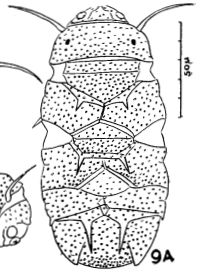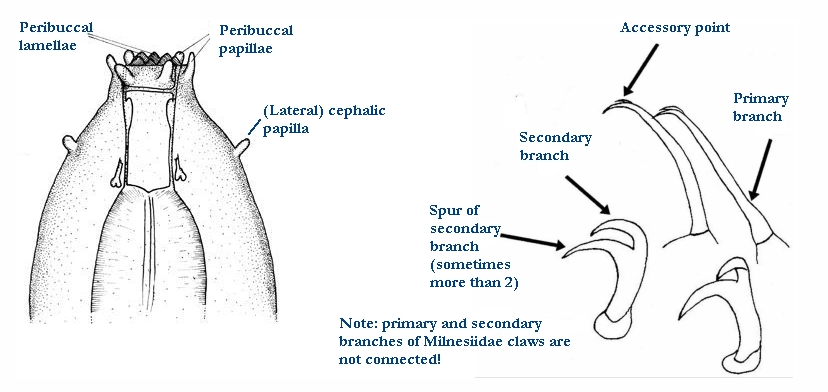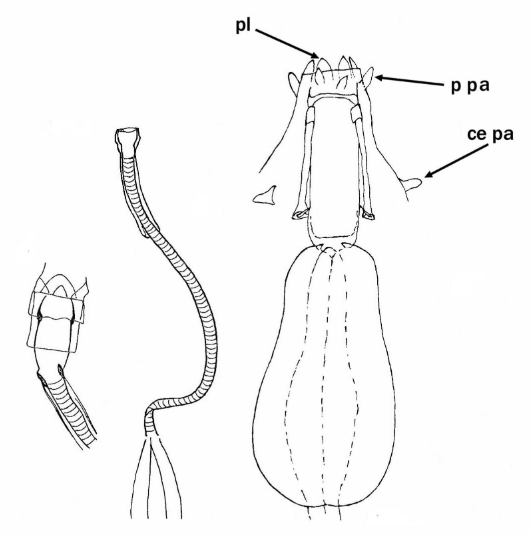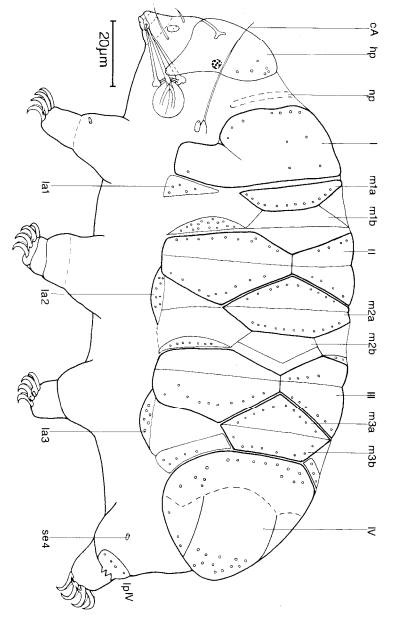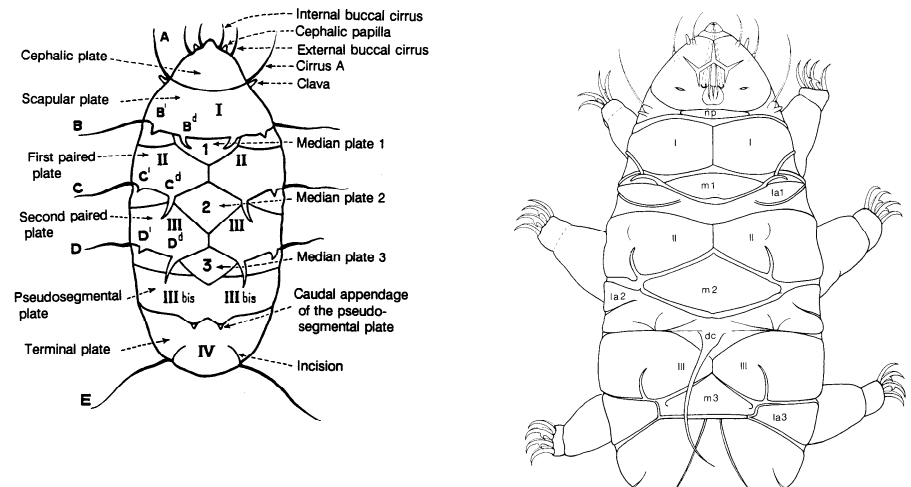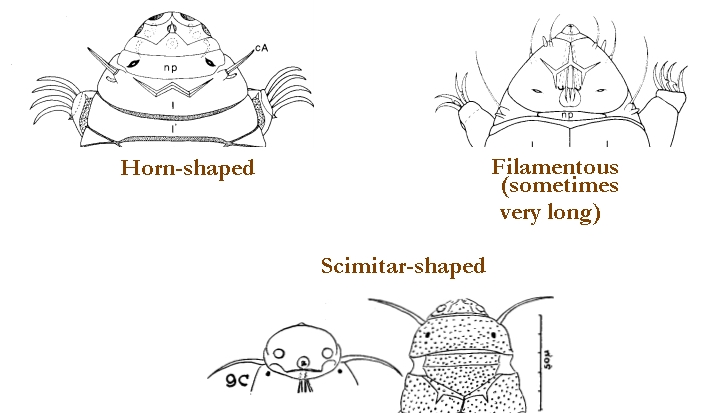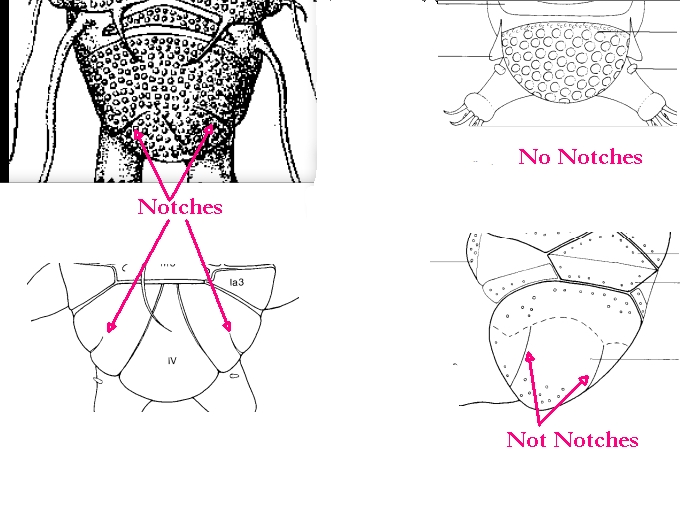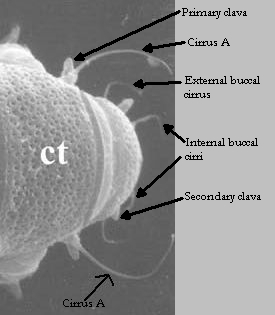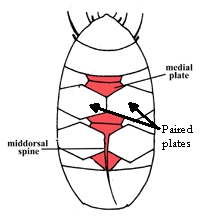From Ramazzotti & Maucci 1983: “The plates are as in Pseudechiniscus; the internal and external buccal cirri are absent.”
From Kristensen 1987: “Red Echiniscidae with black eyes, flexible buccal tube, stylet supports without CaCO3; ventral plates absent. Strongly sculptured dorsal plates. Paired pseudosegmental plates IV; all median plates undivided. A small rectangular plate with a «thorn» present on each side of the scapular plate (I). Cirrus A long stiff spine without cirrophore, primary clavae bent backwards. Internal and external cirri absent, secondary clavae small ovoid dome-shaped in female, large round dome-shaped in male. Emended description: The head bent strongly downwards; the mouth opening and the secondary clavae are located ventrally. The head plate is faceted with a small depression in the middle. The anterior margin of the head plate consists of two lateral ovoid structures. The neck plate is large and has the same sculpture as the head plate. This sculpture consists of coarse granulation and fine punctuation. The punctuation is formed by the pillar structure in the epicuticle. The coarse granulation consists of large, circular raised areas. The plates on the trunk segments have the same double granulation, but the circular raised areas are larger. The scapular plate (I) is relatively small with a rectangular plate on each. Cirri A and primary clavae are located between the scapular plate and the small lateral plates. Smaller lateral plates are also present in connection with the paired segmental plates II and III and the unpaired caudal plate. The large caudal plate has terminal indentation (notches). The posterior margin of the caudal plate is positioned latero-ventrally. The fourth pair of legs insert anterior to the margin of the plate. The median plates 1, 2 and 3 are undivided in adults, the median plate 2 is divided in the 2-clawed larva. Lateral intersegmental plates are present in connection with median plate 1. The reduction of the cephalic sense organs in the genus Mopsechiniscus is unique to the family Echiniscidae. The primary clavae previously overlooked (Marcus, 1929, Du Bois-Raymond Marcus, 1944) are best seen by Nomarski- optics. They are located in small depressions in the cuticle near the large base of the cirrus A. Each clava is bent backwards and adheres to the dorsal cuticle by a thin cuticular membrane. The cirrus A is a short spike in the larva, and a long thick spine in the adult. The cirri lack cirrophores, but each has a swollen base, which is continuous with the flagellum. The same type of cirrus is found on the trunk. The internal and external cirri are absent, the secondary clavae are dome-shaped and located ventrally. The collar or leg plates are absent on all legs, but a coarse granulation occurs on at least the fourth pairs of legs. Typical leg sense organs are located only on the fourth pair of legs. Furthermore, a triangular papilla is found on all legs, located near the base of the tarsus. The function of the latter is unknown, but it could be a muscle attachment. The tarsus is asymmetrical, with a cuticular cusp located near the base of the outer external claw, and a small cuticular cushion on the inner side of the tarsus. Each internal claw has a secondary spur. The 2-clawed larva of Mopsechiniscus has 8 pair of spines on the trunk. The four lateral spines are homologues with cirri B, C, D and E, but the two first pair of dorsal spines are located on the median plates 1 and 2, the third pair are small spine Dd and the fourth pair are pseudosegmental spines. At least two juvenile instars exist. The four-clawed juvenile lacking an anus, has reduced spine B, Dd and E, the four-clawed juvenile with an anus has only small ‘thorn’- shaped cirri B, C and a filiform cirri D. Of the dorsal appendages only the spines on median plate 2 and the pseudosegmental spine are present. The adult has filiform cirri C and D, a small thorn on the lateral plate could be a reduced cirri B. The pseudosegmental plates also have a pair of reduced triangular spines in a few animals. The buccal apparatus has a very long buccal tube. The anterior part of the tube is rigid, but, after the insertion of the very thin cuticular stylet supports, the tube becomes flexible, without CaCO3. The stylets are shorter than the buccal tube and do not reach the pharyngeal bulb. The furcae of the stylets are very large. The armature in the pharyngeal bulb consist of thick bar shaped placoids and a very thin outer cuticular lining.”
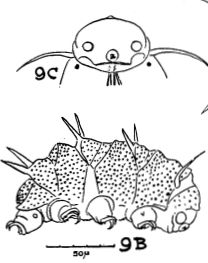
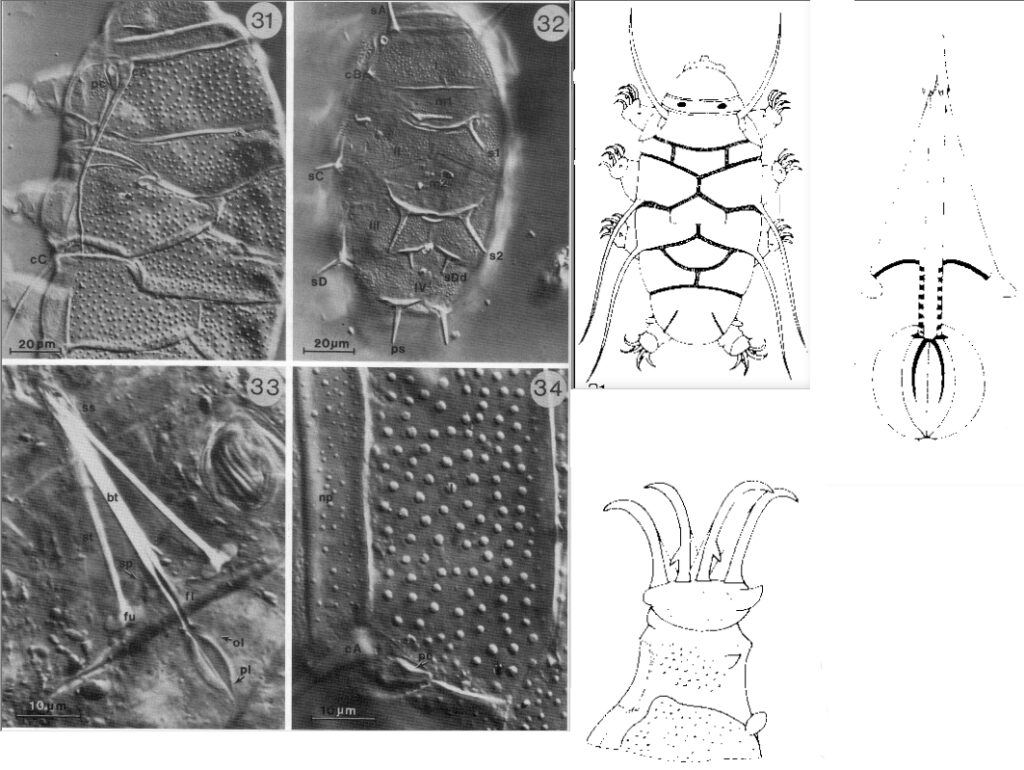
Citations:
Kristensen RM. 1987. Generic revision of the Echiniscidae (Heterotardigrada), with a discussion of the origin of the family. pp. 261-335 in Bertolani R (ed). Biology of Tardigrades: Selected symposia and monographs.
Ramazzotti G, Maucci W. 1983. Il phylum Tardigrada(III edizione riveduta e aggiornata). English translation by C. W. Beasley, 1995. Memorie dell’ Istituto Italiano di Idrobiologia 41: 1-1012.
